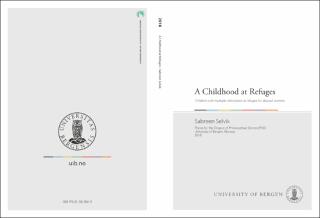| dc.description.abstract | Domestic violence interrupts the home environment and relations of many families, causing thousands of mothers and children yearly to flee home and seek protection in refuges for abused women.1 Some children may experience several relocations at the same or different refuges and may spend large parts of their childhood in refuges. Little research, if any, has been done on children who experience multiple relocations at refuges. This dissertation contributes to filling a gap in the national and international research literature, as there is no authoritative work on children with repetitive stays at refuges, and gives a voice to this group of children who have been marginalized in research. The dissertation points out some of the main challenges children and adolescents with multiple refuge relocations face as a result of their moves in and out of refuges. It also employs children’s voices to explore their perceptions of their school experiences in Norway while living or relocating at refuges. The first part of this study is based on a scope literature review to map the range and gaps in the literature on this group of children. The review shows major discrepancies across the Nordic countries (Norway, Denmark, Iceland, Finland, and Sweden) regarding which data are collected (if any), how the data are presented for this group of children, and the help and services provided in general for children at refuges. It also identifies three major challenges these children face: their prolonged exposure to domestic violence, disruption of close relationships, and repeated disruptions in school and preschool attendance. According to the available literature on the impact of domestic violence on children, these challenges suggest reasons for concern regarding the possible high risk for these children of developing social and psychosocial difficulties, limited access to resources that can help develop their resilience to violence, and school failure and dropout. The second part is based on a qualitative approach using semi-structured interviews with 20 children and adolescents (aged 7–16) who had at least one previous stay at a refuge. They were recruited from five Norwegian refuges located in different cities. The interviews were analysed using the coding system of Charmaz’s constructivist approach to grounded theory as a method. The data analysis produced two concepts: recognition and control/thought control. These concepts were used as guidance for the choices of theoretical framework: the concepts of mutual recognition (Schibbye 2009) and self-efficacy and thought control (Bandura 1997). The fieldwork shows the complexity of the living conditions of these children. Their “normal” everyday life is fragmented and divided between home and refuges. These repetitive stays can last for days, weeks, or months at a time which means that there could be children who spend large parts or even the majority of their childhood at refuges. Thus, for these children, domestic violence is not an isolated incident but part of their everyday life. At school, children describe receiving little if any teacher support. They describe five different types of recognitions of their situation (formal, forced, practical, third-party, and coincidental recognition). Except in cases of formal recognition, children express ambiguity and uncertainty regarding their teacher’s involvement with and knowledge of their situation. The majority of children struggled with concentration difficulties triggered by thoughts about secrecy, safety, insecurity about the future, and flashbacks of violence. However, children were mostly left on their own to deal with these difficulties while at school. Only a few managed to control these difficulties through strategies such as imaginative safety, recreational learning, healing talks, physical activity, divertive play, and creative explanations. The findings of this dissertation suggest reason to be concerned about children with multiple refuge relocations at refuges for abused women. Their life experiences show a breach of the rights of the child as stated in several articles in the United Nations Convention on the Rights of the Child. The findings call for policy makers and the agencies involved in supporting these children to rethink their polices and routines and revaluate their cooperation procedures. A better registration system may help in identifying these children. However, this may require adaptations in refuge systematic registration and case transfer routines, a reconsideration data retention regulations, and rethinking options for a common registration base for Norwegian refuges. Schools, and especially teachers, play an important role in shaping children’s beliefs, not only about their social and academic abilities at school, but also in their abilities to persevere under difficult life circumstances. The lack of teacher support revealed in this dissertation calls for further research to understand the needs and difficulties teachers face, in order to tailor interventions that can support them in fulfilling their role, duties, and obligations towards these children. Further research in different fields is needed to expand the body of literature on this group of children. | en_US |
| dc.relation.haspart | Paper I: Selvik, S., & Øverlien, C. (2015). Children with multiple stays at Nordic refuges for abused women: conclusions, challenges, and causes for concern. Nordic Social Work Research, 5(2), 98-112. Full text not available in BORA due to publisher restrictions. The article is available at: <a href="https://doi.org/10.1080/2156857X.2014.982158" target="blank">https://doi.org/10.1080/2156857X.2014.982158</a> | eng |
| dc.relation.haspart | Paper II: Selvik, S., Raaheim, A., & Øverlien, C. (2017). Children with multiple stays at refuges for abused women and their experiences of teacher recognition. European Journal of Psychology of Education, 32(3), 463-481. Full text not available in BORA due to publisher restrictions. The article is available at: <a href="https://doi.org/10.1007/s10212-016-0302-0" target="blank">https://doi.org/10.1007/s10212-016-0302-0</a> | eng |
